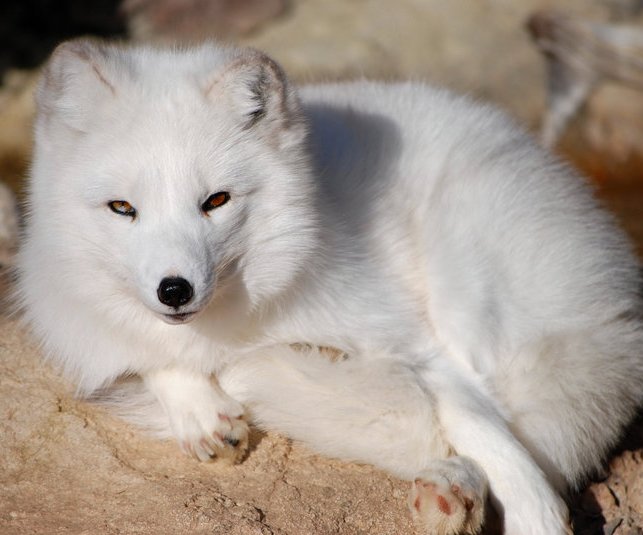
Arctic fox (domesticated) (Vulpes lagopus)
Phylum —chordata
Class — mammalia
Order — carnivora
Family — canidae
Genus – vulpes
Appearance
It has a deep thick fur which is white in winter and brown in summer.
Its body length ranges from 46 to 68 cm (18 to 27 in), with a generally rounded body shape to minimize the escape of body heat.
Habitat
The Arctic fox lives in Arctic and Subarctic regions of Russia, Europe and North America. It lives in the circumpolar Arctic, which stretches from the top of Ellesmere Island to the bottom of James Bay in Canada. It is mostly found on tundra and pack ice, but it also lives in boreal forests in the Kenai Peninsula in Alaska and in Canada.
Behavior
Arctic foxes are diurnal animals. They live in a family consisting of one adult male, the young, and two vixens - one a non-breeding female born the year before that helps look after the next litter. The fox makes a den far beneath the surface of the ground. It can tolerate temperatures as low as -50 degrees Celsius. Their dens have a number of entrances and have been lived in by generations of foxes for centuries. To locate prey during winter, the fox uses its sense of smell and hearing to find animals moving through tunnels underneath the snow.
Diet
The Arctic fox is an omnivore and will eat almost any animal, dead or alive. It prefers small mammals but will eat berries, insects, carrion, and even animal or human stools. In winter it usually eats sea mammals and birds, invertebrates, fish, and seals.
Reproduction
Arctic foxes tend to form monogamous pairs in the breeding season and maintain a territory around the den. Breeding is usually in April and May, with a gestation period of about 52 days. Between 6 and 19 cubs are born. They drink milk until they are able to eat solid food, starting to eat after 6 weeks. They leave the den when they are 14-15 weeks old. They are usually dependent on their parents from summer to autumn. Both male and female parents take care of the cubs, with the female raising the young while the male hunts for food. At one year old they are sexually mature.
In the wild, most individuals do not live past their first year but some exceptional ones survive up to 11 years.
In captivity
Having a proper, secure enclosure setup is one of the most important requirements when owning a fox. Fox kits may tolerate staying indoors, but once they hit sexual maturity, they start marking their territory with their urine and feces and become extremely destructive.Having an enclosure is also great because even if you keep your fox indoors, they cannot be left unsupervised. Enclosures give your fox plenty of space to roam and play, even when you aren't home. In terms of enrichment, the enclosure should also include ramps, platforms, hanging toys, tunnel tubes, sandboxes, and toys. Enclosures should have a nesting box (or dog house), food and water dishes (which are best clipped to the fence, to avoid your fox marking inside them and soiling the water), and optionally a substrate such as aspen bedding or straw. They should also be cleaned twice a week, or every day, depending on the size.
Some people prefer to raw feed their foxes, or prepare homemade meals. Here is a well researched, excellent recipe:
Ingredients:
- 2 lbs raw ground chicken;
- 2 lbs raw ground turkey;
- 8 hardboiled eggs (shells powdered and included);
- 4 oz raw tilapia;
- 1.5 cups rolled oats;
- 1 (411g) can green beans;
- 1/2 cup ground flaxseed;
- 1 tbsp carrot juice;
- 4 tsp wheat germ oil;
- 1 tsp cod liver oil.
Foxes will cache their food. They will also mark it with their feces or urine. Therefore, it is important that you keep your feeding areas clean, and ensure that leftover perishable food is not being cached.
 Russian
Russian
 English
English























